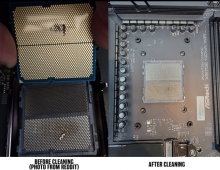
AMD to demo a dual-core desktop chip
Advanced Micro Devices is expected show off a dual-core processor for desktops at its headquarters Wednesday, but is keeping tight lipped about the details.
The chip, code-named Toledo, will feature two separate Athlon 64 processing cores on the same piece of silicon. It will start appearing in PCs in the second half of 2005, said Theresa DeOnis, desktop brand manager for AMD.
Putting two cores on a chip will allow a computer to perform two tasks at once, she said, or run specially tweaked applications faster. Windows XP Professional will be the operating system of choice for many dual-core desktops as it is already threaded to run two processors.
"We don't have a lot of multithreaded applications on the market yet, but it (Toledo) will perform will in multitasking environments," she said.
The chip will come in the same package and fit in the same PCs as current single-core Athlons, DeOnis said. Nonetheless, she declined to provide the clock speed or other details.
AMD and rival Intel will both start coming out with dual-core chips this year and each can claim to be ahead of the other in different ways. Intel's first dual core chip for desktops, code-named Smithfield, will come out in the second quarter, ahead of Toledo.
AMD, however, will come out with a dual-core version of its Opteron chip for servers in the middle of the year. Intel won't have a dual-core Xeon until 2006, although it will release a dual-core Itanium in the second quarter. IBM has been selling a dual-core chip for servers, The Power4, for a few years.
Dual-core chips are an easier fit for the server market as many servers come with two processors already. However, the number of server chips shipped in a year pale in comparison to the number of desktop chips. Server customers are also notoriously conservative, so adoption won't take place immediately, analysts have said.
In the gamer desktop market, Intel will come out with a dual core-chip for high-end PCs this year that will also sport HyperThreading, which effectively will allow the chip to mimic, to a certain degree, a four-processor system. AMD won't likely do so until 2006, DeOnis said, but that's because most games aren't multithreaded and therefore can't effectively take advantage of two cores.
Intel's first dual-core chip for notebooks, code-named Yonah, comes out late this year. AMD won't have a notebook chip until after Toledo. Toledo can be used in notebooks, DeOnis said, but it has a 110-watt thermal envelope, relatively high for a notebook chip.
From News.com





















